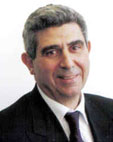Constantinos Stavrinidis
Prof. Dr Stavrinidis graduated in Aeronautical Engineering (Bachelor and Master of Science) from Imperial College, University of London and obtained Doctorates in Structural Dynamics from University of Stuttgart (Dr Ing.), Germany, and Imperial College University of London (PhD), England. Prof. Dr Stavrinidis received in 2011 an Honorary Doctorate from the Moscow Aviation Institute (MAI). Prof. Dr Stavrinidis was awarded in 2012 the Eugen-Sänger medal.
Prof. Dr Stavrinidis has published over 80 papers, many in refereed journals, and he is a visiting Professor in the Surrey Space Centre, University of Surrey, and the Engineering Department of University of Strathclyde, Glasgow, UK.
He worked in industry with Lloyds Register of Shipping and Kongsberg. He joined the European Space Agency (ESA) in 1976 where he has been successively in charge of the Structures Section, and the Structures and Mechanisms Division. He is Head of the Mechanical Engineering Department which covers the major space disciplines Structures, Mechanisms, Optics, Optoelectronics, Life and Physical Sciences, Environmental Control and Life Support (ECLSS), Automation and Robotics, Thermal Control, Propulsion and Aerothermodynamics, and Test facilities for verification of space vehicles systems and subsystems. The Department is responsible for the developments that are being performed in these areas in Agency technology, and Satellite Programmes.
Prof. Dr Stavrinidis is a Chartered Engineer with the UK Engineering Council, Fellow of the Royal Aeronautical Society (RAeS), Fellow of the American Institute of Aeronautics and Astronautics (AIAA), Member of International Academy of Astronautics (IAA), Member of Académie de l'Air et de l'Espace (AAE), Space Branch Chairman of the Council of European Aerospace Societies (CEAS), Member of the Structures and Materials Committee of the RAeS Specialist Group, Chairman of the International Astronautics Federation (IAF) Committee on Materials and Structures, and Chairman of NAFEMS the professional association on simulation technology for the engineering analysis community. Prof. Dr Stavrinidis is member of the Technology Advisory Board (TAB) of the Imperial College Aeronautics Department. He is member of the Advisory Board of the Governing Body of the University of Delft, The Netherlands.
Space Vehicle Development and Verification
Prof. Dr. C. Stavrinidis
Head of Mechanical Engineering Department The European Space Agency, ESTEC, Noordwijk, The Netherlands
The presentation covers challenges in space vehicle development and verification. Recent advancements are presented in the area of structural design, analysis, and verification testing of satellites and launchers.
Analysis and test advancements are presented in the area of dynamic loads to cover adequately dynamic excitations induced during launch e.g. transient, acoustics, and shocks in space vehicle design and verification.
Microvibration issues are addressed as they arise in scientific satellites with high pointing stability, and satellites using laser communication terminals. Analysis and test advancements are presented for evaluating the criticality of microvibrations, and measuring at micronewton level such effects that arise from satellite reaction wheels and propulsion system thrust perturbations.
Sloshing problems and fluid structure interaction issues arising in space vehicles are addressed with respect to their contribution in space vehicle system dynamics, and the advancement of related verification techniques.
Vibroacoustic advancements are presented in combining finite element analysis methods with statistical energy analysis techniques to cover adequately vibroacoustic excitations contributing to the frequency range of interest.
Advancements in thermal testing at high temperatures are presented to verify adequately satellite systems of planetary missions.
Finally work in progress is presented for a number of on-going R&D activities with respect to the health monitoring of structures, reduction of separation shocks, and advancement of space vehicle mechanical systems.
